Dian Li
Fact-R1: Towards Explainable Video Misinformation Detection with Deep Reasoning
May 22, 2025Abstract:The rapid spread of multimodal misinformation on social media has raised growing concerns, while research on video misinformation detection remains limited due to the lack of large-scale, diverse datasets. Existing methods often overfit to rigid templates and lack deep reasoning over deceptive content. To address these challenges, we introduce FakeVV, a large-scale benchmark comprising over 100,000 video-text pairs with fine-grained, interpretable annotations. In addition, we further propose Fact-R1, a novel framework that integrates deep reasoning with collaborative rule-based reinforcement learning. Fact-R1 is trained through a three-stage process: (1) misinformation long-Chain-of-Thought (CoT) instruction tuning, (2) preference alignment via Direct Preference Optimization (DPO), and (3) Group Relative Policy Optimization (GRPO) using a novel verifiable reward function. This enables Fact-R1 to exhibit emergent reasoning behaviors comparable to those observed in advanced text-based reinforcement learning systems, but in the more complex multimodal misinformation setting. Our work establishes a new paradigm for misinformation detection, bridging large-scale video understanding, reasoning-guided alignment, and interpretable verification.
Critique Before Thinking: Mitigating Hallucination through Rationale-Augmented Instruction Tuning
May 12, 2025Abstract:Despite significant advancements in multimodal reasoning tasks, existing Large Vision-Language Models (LVLMs) are prone to producing visually ungrounded responses when interpreting associated images. In contrast, when humans embark on learning new knowledge, they often rely on a set of fundamental pre-study principles: reviewing outlines to grasp core concepts, summarizing key points to guide their focus and enhance understanding. However, such preparatory actions are notably absent in the current instruction tuning processes. This paper presents Re-Critic, an easily scalable rationale-augmented framework designed to incorporate fundamental rules and chain-of-thought (CoT) as a bridge to enhance reasoning abilities. Specifically, Re-Critic develops a visual rationale synthesizer that scalably augments raw instructions with rationale explanation. To probe more contextually grounded responses, Re-Critic employs an in-context self-critic mechanism to select response pairs for preference tuning. Experiments demonstrate that models fine-tuned with our rationale-augmented dataset yield gains that extend beyond hallucination-specific tasks to broader multimodal reasoning tasks.
Adaptive Subsampling and Learned Model Improve Spatiotemporal Resolution of Tactile Skin
Oct 17, 2024



Abstract:High-speed tactile arrays are essential for real-time robotic control in unstructured environments, but high pixel counts limit readout rates of most large tactile arrays to below 100Hz. We introduce ACTS - adaptive compressive tactile subsampling - a method that efficiently samples tactile matrices and reconstructs interactions using sparse recovery and a learned tactile dictionary. Tested on a 1024-pixel sensor array (32x32), ACTS increased frame rates by 18X compared to raster scanning, with minimal error. For the first time in large-area tactile skin, we demonstrate rapid object classification within 20ms of contact, high-speed projectile detection, ricochet angle estimation, and deformation tracking through enhanced spatiotemporal resolution. Our method can be implemented in firmware, upgrading existing low-cost, flexible, and robust tactile arrays into high-resolution systems for large-area spatiotemporal touch sensing.
Innovative Thinking, Infinite Humor: Humor Research of Large Language Models through Structured Thought Leaps
Oct 14, 2024



Abstract:Humor is a culturally nuanced aspect of human language that presents challenges for understanding and generation, requiring participants to possess good creativity and strong associative thinking. Similar to reasoning tasks like solving math problems, humor generation requires continuous reflection and revision to foster creative thinking, rather than relying on a sudden flash of inspiration like Creative Leap-of-Thought (CLoT) paradigm. Although CLoT can realize the ability of remote association generation, this paradigm fails to generate humor content. Therefore, in this paper, we propose a systematic way of thinking about generating humor and based on it, we built Creative Leap of Structured Thought (CLoST) frame. First, a reward model is necessary achieve the purpose of being able to correct errors, since there is currently no expert model of humor and a usable rule to determine whether a piece of content is humorous. Judgement-oriented instructions are designed to improve the capability of a model, and we also propose an open-domain instruction evolutionary method to fully unleash the potential. Then, through reinforcement learning, the model learns to hone its rationales of the thought chain and refine the strategies it uses. Thus, it learns to recognize and correct its mistakes, and finally generate the most humorous and creative answer. These findings deepen our understanding of the creative capabilities of LLMs and provide ways to enhance LLMs' creative abilities for cross-domain innovative applications.
Chip-Tuning: Classify Before Language Models Say
Oct 09, 2024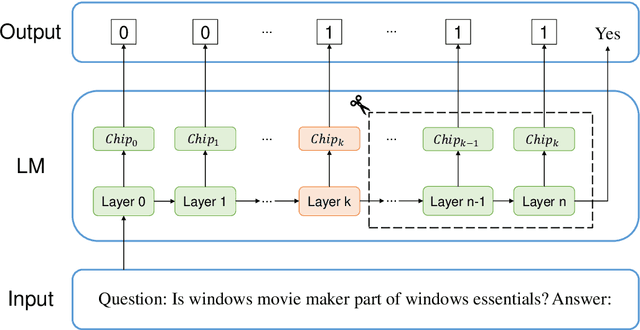
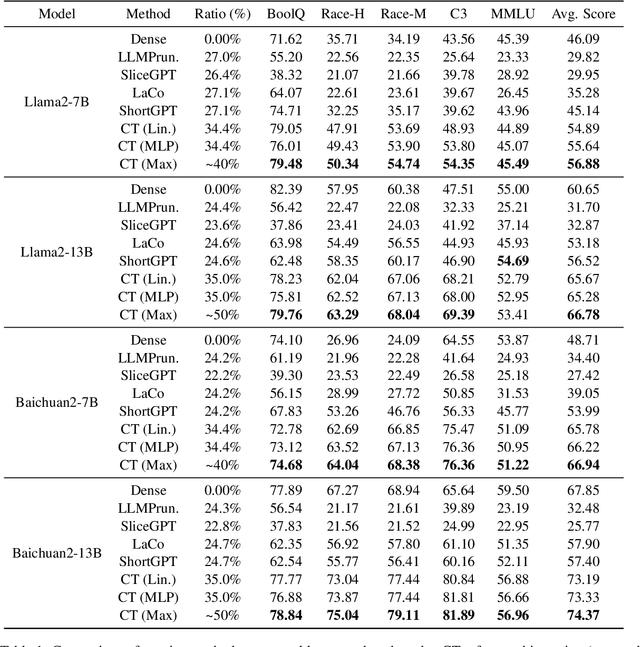
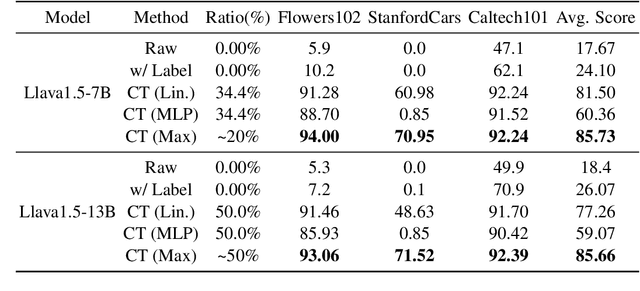
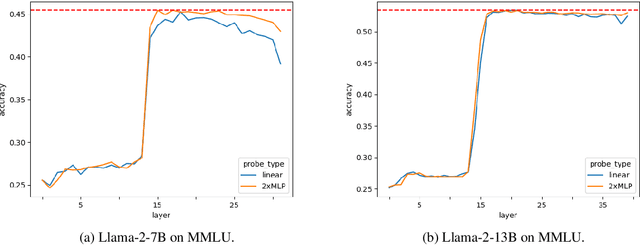
Abstract:The rapid development in the performance of large language models (LLMs) is accompanied by the escalation of model size, leading to the increasing cost of model training and inference. Previous research has discovered that certain layers in LLMs exhibit redundancy, and removing these layers brings only marginal loss in model performance. In this paper, we adopt the probing technique to explain the layer redundancy in LLMs and demonstrate that language models can be effectively pruned with probing classifiers. We propose chip-tuning, a simple and effective structured pruning framework specialized for classification problems. Chip-tuning attaches tiny probing classifiers named chips to different layers of LLMs, and trains chips with the backbone model frozen. After selecting a chip for classification, all layers subsequent to the attached layer could be removed with marginal performance loss. Experimental results on various LLMs and datasets demonstrate that chip-tuning significantly outperforms previous state-of-the-art baselines in both accuracy and pruning ratio, achieving a pruning ratio of up to 50%. We also find that chip-tuning could be applied on multimodal models, and could be combined with model finetuning, proving its excellent compatibility.
Video-CCAM: Enhancing Video-Language Understanding with Causal Cross-Attention Masks for Short and Long Videos
Aug 26, 2024Abstract:Multi-modal large language models (MLLMs) have demonstrated considerable potential across various downstream tasks that require cross-domain knowledge. MLLMs capable of processing videos, known as Video-MLLMs, have attracted broad interest in video-language understanding. However, videos, especially long videos, contain more visual tokens than images, making them difficult for LLMs to process. Existing works either downsample visual features or extend the LLM context size, risking the loss of high-resolution information or slowing down inference speed. To address these limitations, we apply cross-attention layers in the intermediate projector between the visual encoder and the large language model (LLM). As the naive cross-attention mechanism is insensitive to temporal order, we further introduce causal cross-attention masks (CCAMs) within the cross-attention layers. This Video-MLLM, named Video-CCAM, is trained in a straightforward two-stage fashion: feature alignment and visual instruction tuning. We develop several Video-CCAM models based on LLMs of different sizes (4B, 9B, and 14B). Video-CCAM proves to be a robust Video-MLLM and shows outstanding performance from short videos to long ones. Among standard video benchmarks like MVBench and VideoChatGPT-QA, Video-CCAM shows outstanding performances (1st/2nd/3rd in MVBench and TGIF-QA, 2nd/3rd/4th in MSVD-QA, MSRVTT-QA, and ActivityNet-QA). In benchmarks encompassing long videos, Video-CCAM models can be directly adapted to long video understanding and still achieve exceptional scores despite being trained solely with images and 16-frame videos. Using 96 frames (6$\times$ the training number of frames), Video-CCAM models rank 1st/2nd/3rd in VideoVista and 1st/2nd/4th in MLVU among all open-source Video-MLLMs, respectively. The code is publicly available in \url{https://github.com/QQ-MM/Video-CCAM}.
MetaTool: Facilitating Large Language Models to Master Tools with Meta-task Augmentation
Jul 15, 2024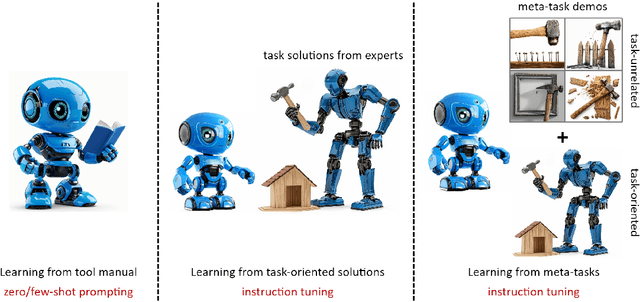

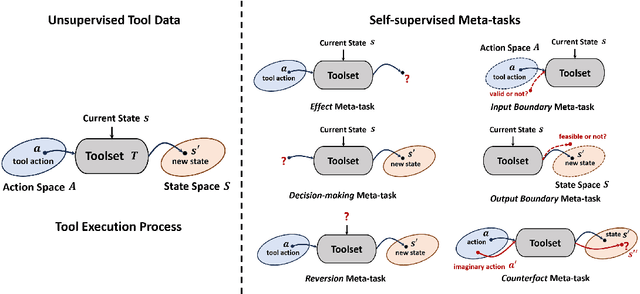
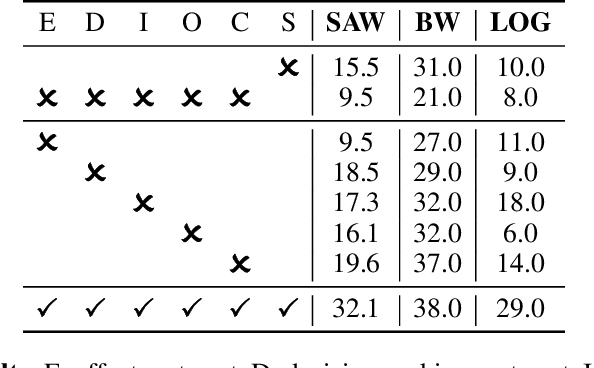
Abstract:Utilizing complex tools with Large Language Models (LLMs) is a critical component for grounding AI agents in various real-world scenarios. The core challenge of manipulating tools lies in understanding their usage and functionality. The prevailing approach involves few-shot prompting with demonstrations or fine-tuning on expert trajectories. However, for complex tools and tasks, mere in-context demonstrations may fail to cover sufficient knowledge. Training-based methods are also constrained by the high cost of dataset construction and limited generalizability. In this paper, we introduce a new tool learning methodology (MetaTool) that is generalizable for mastering any reusable toolset. Our approach includes a self-supervised data augmentation technique that enables LLMs to gain a comprehensive understanding of various tools, thereby improving their ability to complete tasks effectively. We develop a series of meta-tasks that involve predicting masked factors of tool execution. These self-supervised tasks enable the automatic generation of high-quality QA data concerning tool comprehension. By incorporating meta-task data into the instruction tuning process, the proposed MetaTool model achieves significant superiority to open-source models and is comparable to GPT-4/GPT-3.5 on multiple tool-oriented tasks.
Vision-Language Instruction Tuning: A Review and Analysis
Nov 25, 2023



Abstract:Instruction tuning is a crucial supervised training phase in Large Language Models (LLMs), aiming to enhance the LLM's ability to generalize instruction execution and adapt to user preferences. With the increasing integration of multi-modal data into LLMs, there is growing interest in Vision-Language Instruction Tuning (VLIT), which presents more complex characteristics compared to pure text instruction tuning. In this paper, we systematically review the latest VLIT settings and corresponding datasets in multi-modal LLMs and provide insights into the intrinsic motivations behind their design. For the first time, we offer a detailed multi-perspective categorization for existing VLIT datasets and identify the characteristics that high-quality VLIT data should possess. By incorporating these characteristics as guiding principles into the existing VLIT data construction process, we conduct extensive experiments and verify their positive impact on the performance of tuned multi-modal LLMs. Furthermore, we discuss the current challenges and future research directions of VLIT, providing insights for the continuous development of this field. The code and dataset related to this paper have been open-sourced at https://github.com/palchenli/VL-Instruction-Tuning.
HumTrans: A Novel Open-Source Dataset for Humming Melody Transcription and Beyond
Sep 18, 2023



Abstract:This paper introduces the HumTrans dataset, which is publicly available and primarily designed for humming melody transcription. The dataset can also serve as a foundation for downstream tasks such as humming melody based music generation. It consists of 500 musical compositions of different genres and languages, with each composition divided into multiple segments. In total, the dataset comprises 1000 music segments. To collect this humming dataset, we employed 10 college students, all of whom are either music majors or proficient in playing at least one musical instrument. Each of them hummed every segment twice using the web recording interface provided by our designed website. The humming recordings were sampled at a frequency of 44,100 Hz. During the humming session, the main interface provides a musical score for students to reference, with the melody audio playing simultaneously to aid in capturing both melody and rhythm. The dataset encompasses approximately 56.22 hours of audio, making it the largest known humming dataset to date. The dataset will be released on Hugging Face, and we will provide a GitHub repository containing baseline results and evaluation codes.
TagGPT: Large Language Models are Zero-shot Multimodal Taggers
Apr 06, 2023


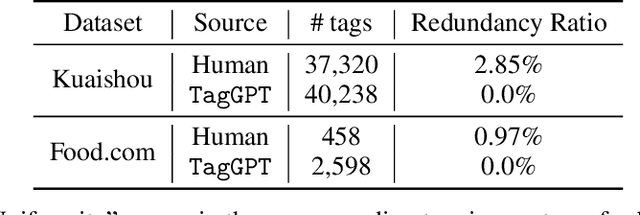
Abstract:Tags are pivotal in facilitating the effective distribution of multimedia content in various applications in the contemporary Internet era, such as search engines and recommendation systems. Recently, large language models (LLMs) have demonstrated impressive capabilities across a wide range of tasks. In this work, we propose TagGPT, a fully automated system capable of tag extraction and multimodal tagging in a completely zero-shot fashion. Our core insight is that, through elaborate prompt engineering, LLMs are able to extract and reason about proper tags given textual clues of multimodal data, e.g., OCR, ASR, title, etc. Specifically, to automatically build a high-quality tag set that reflects user intent and interests for a specific application, TagGPT predicts large-scale candidate tags from a series of raw data via prompting LLMs, filtered with frequency and semantics. Given a new entity that needs tagging for distribution, TagGPT introduces two alternative options for zero-shot tagging, i.e., a generative method with late semantic matching with the tag set, and another selective method with early matching in prompts. It is well noticed that TagGPT provides a system-level solution based on a modular framework equipped with a pre-trained LLM (GPT-3.5 used here) and a sentence embedding model (SimCSE used here), which can be seamlessly replaced with any more advanced one you want. TagGPT is applicable for various modalities of data in modern social media and showcases strong generalization ability to a wide range of applications. We evaluate TagGPT on publicly available datasets, i.e., Kuaishou and Food.com, and demonstrate the effectiveness of TagGPT compared to existing hashtags and off-the-shelf taggers. Project page: https://github.com/TencentARC/TagGPT.
 Add to Chrome
Add to Chrome Add to Firefox
Add to Firefox Add to Edge
Add to Edge